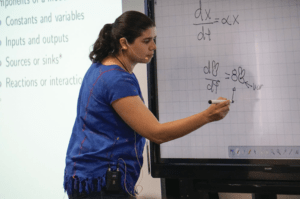 The alarm rings, you open your eyes, you turn it off. You feel pain in the throat, nasal flow, headache and the thermometer indicates 38°C. You have a cold. The immune system has to be activated quickly to fight the virus. But that’s not all, besides the virus, there are bacteria trying to infect the respiratory tract. That means that the immune system has to change its strategy to defeat the two invaders. How to achieve it?
The alarm rings, you open your eyes, you turn it off. You feel pain in the throat, nasal flow, headache and the thermometer indicates 38°C. You have a cold. The immune system has to be activated quickly to fight the virus. But that’s not all, besides the virus, there are bacteria trying to infect the respiratory tract. That means that the immune system has to change its strategy to defeat the two invaders. How to achieve it?
“To maintain our homeostasis we need to constantly change and adapt to the environment,” said Mariana Martínez Sánchez, PhD in Biomedical Sciences, during her presentation titled “Plasticity in the Immune System: From Model to Mechanisms” at Immunoinformatics 2019.
Martínez, is a Post-Doctoral researcher at the UNAM Institute of Ecology and a member of C3, spoke about the mathematical models she uses to perform analyses for her research. “With mathematics I can represent the problem because mathematics is a logical system”, said Martinez.
Martínez research focuses on analysing the plasticity of T cells, in particular understanding the plasticity and ability of these cells to respond to the environment and modify themselves. Her study focused on CD4+ cells, a subfamily of T lymphocytes also known as helper T lymphocytes, which represent a key cell for the immune system plasticity. The “CD4 + cells are very important” because they “activate or inhibit different types of immune responses,” said Martinez.
The CD4+ cells sense and integrate the environmental signals to induce the specific production of cytokines that regulate the response of other cells. CD4+ T cells that have not been previously activated are known as näive or Th0 cells. When they recognise an antigen, and depending on the cytokines and other molecular cues in the microenvironment, they can differentiate into different phenotypes with different functions, such as Th1 or Th2 cells, among other.
To study changes in cells, Martínez and colleagues used simulations that were analysed by continuous models that enabled her to observe the transitions between cell types, as well as the effects or feedback that they have in their environment. Martinez presented some of her analysis during her talk, her research showed that “there are plastic cells and there are cells that do not change. The plasticity is asymmetric”. That is, “different cells [of the CD4+ group] have different capacity to change”.
This is a first step to understand the complex regulatory networks that come into play when the immune system is the challenged with different pathogens, such as virus and bacterium, simultaneously.
(Translated by Jennifer Enciso)











